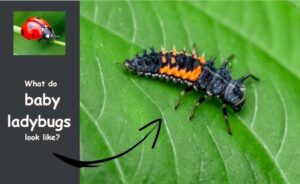Have you spotted thrips on your houseplant or garden and are searching for a functional natural way to get rid of them? Indeed, ladybugs eat thrips and getting help from them can be a perfect strategy if you know how to use the ladybirds. Join me in this blog to tell you all things you should know.
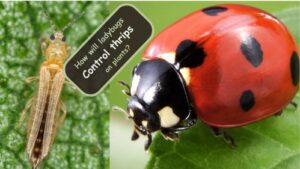
If you keep reading, I will answer the following questions:
- How will ladybugs control thrips on plants? Do ladybirds eat thrips?
- ladybugs eat thrips at which stage of their life cycle? Adults or larvae?
- How to use ladybirds to control thrips on your houseplant or garden?
- What are the pro tips to raise efficiency?
My academic major is plant protection and I am a houseplant gardener. Hence feel free to ask your questions below this page. I will help you as soon as possible. if you are ready, let’s get going.
Thrips on Indoor and Outdoor Plants
First, I am going to give you a brief overview of the thrips. However, if you are an experienced gardener and are familiar with these white-grey tiny bugs on plants, jump to the next part.
Thrips feed on fresh leaves and stems and suck the plant sap. Hence, they can kill your nice houseplants or outdoor plants before you decide how to get rid of them. They can spread quickly on other plants too and can cause trouble. Do you know where thrips come from?
In the below picture, you can see thrips on a plant, grab your magnifying glass and compare your tiny bugs with them.
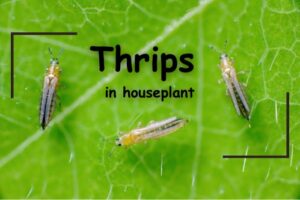
My experience in plant protection shows device a sound plan to kill any pest is based on the habits of the culprits. Hence, read “Thrips on Houseplant” to know more about them. I will give you pro tips about these dangerous bugs.
In addition, I recommend reading “Get rid of thrips naturally” to find out other organic ways to control them. Now that you have found out thrips can kill your lovely indoor plants, do you think thrips can bite you or your pet?
How Can Ladybugs Eat Thrips on Plants?
Ladybugs are one of the efficient predator insects that can decrease the population of a lot of plant pests such as thrips, mealybugs, aphids, spider mites, whiteflies, etc. Hence, they are the close friends of gardeners.
They do their task easily by eating the pests like thrips. So, do ladybugs eat thrips? Yes, they do. In the following, you can see the life cycle of thrips on plants. Every female thrips lives up to 30 days and can lay 2-10 eggs every day, and every egg will get to adult thrips after about 2 weeks. It is trouble! Isn’t it?
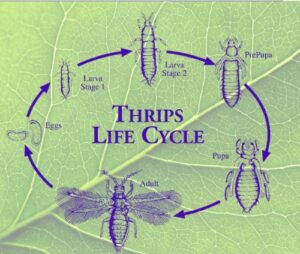
In this situation, ladybugs will help us by eating both eggs and adult thrips. Thanks to ladybugs.
Now, come on to tell you which age of ladybugs is more important to controlling thrips? larvae or adult insects? Keep reading.
Do Ladybugs Eat Thrips at All Stages of Their Life Cycle?
The good news is that both adults and larvae of ladybugs eat thrips. It is very important because it takes 45 days for to larvae become adults. How long do ladybugs live? They can live up to one year.
Hence, during their long life, both larvae and adults can be beneficial. Indeed, larvae are as beneficial as adults and even more. The researches show that ladybugs’ larvae are more gobbler, so, they can eat more thrips. the larvae can eat 10 times more than adults.
What Do Baby Ladybugs Look Like?
I am sure you are familiar with adult ladybugs but have you ever seen their baby (larvae)? In the following image, you can see them. They are similar to a tiny black alligator with orange dots on its back. I believe that ladybugs are very pretty insects but do you think which one is more beautiful? Larvae or adults?
How to Use Ladybugs to Eat Thrips on Indoor and Outdoor Plants.
If you want to get help from ladybugs to remove thrips from your plant, you have to:
- Buy ladybugs and release them in your garden or houseplant.
- Attract the native ladybugs to your garden.
The new research recommends attracting native ladybugs to your garden instead of buying and releasing a new population. If you buy ladybugs and release them in your garden, they may leave there, cannot match with a new environment or even be sick and transfer new diseases to the native population of your garden.
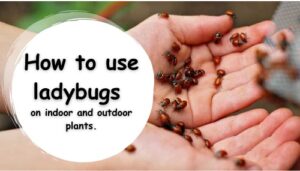
In the following, I will give you tips on how to attract ladybugs to your garden. then, if you are going to control thrips on houseplants by ladybugs, you should buy or collect them from environments. So, keep reading to tell you where ladybugs live to collect them.
Finally, if you are going to buy ladybugs for your houseplant or garden, I will tell you pro tips that raise their efficiency.
First Point: Attract Ladybugs to Eat Thrips in Your Garden.
To attract ladybirds into your garden, you must know about the habits of ladybugs. Do you know ladybugs eat and drink?
What do ladybugs eat and drink?
Ladybugs eat thrips and other soft insects including most plants’ pests such as aphids, mealybugs, thrips, etc. They also feed on fungi. In addition, they drink water, honeydew and nectar. Hence to attract them into your garden to eat thrips, you should provide attractive foods, drinks and homes for them. keep reading to know more.
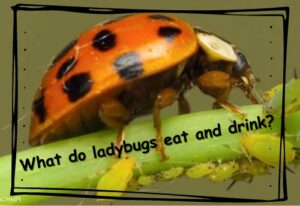
- Attract ladybugs with a water source. Tired passing ladybugs will stop in your garden to drink if you put shallow water bowls with small stones or damp paper towels in your garden.
- Attract ladybugs with a food source. Aphids are a favourite food of ladybugs and if you plant nasturtiums, radishes, early cabbages, and marigolds, aphids attract to them and ladybugs attract to eat aphids. However, inviting aphids into your garden can be harmful to your garden too.
- Make a shelter for ladybugs. You can plant oregano and thyme that make a safe shelter for ladybugs and protect them from toads, birds and other hunters.
You can also build a woody home with a lot of small holes and put delicious food into it. it will attract ladybugs and other beneficial insects like green lacewings.
Second Point: Invite Ladybugs to Your Home to Eat Thrips on Your Houseplant
Now you find out that ladybugs eat thrips, if you get help for controlling thrips on your houseplant, you can collect them from outdoors and release them on indoor plants. Please leave the ladybugs out after eating all thrips before they die without food. As mentioned above, their life span is about one year, hence don’t leave them without food and drink.
Now, I am going to tell you where you can find ladybugs. Keep reading.
Where Do Ladybugs Live?
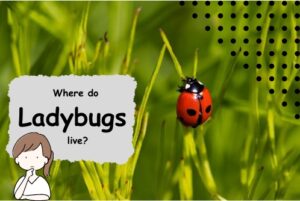
You may find them anywhere such as grasslands, forests, rivers, fields, gardens and even at houses. They like to hide in shrubs and trees. although ladybugs eat thrips, Aphids are their favourite food; hence they most often live everywhere that aphids are living.
So, you can find them on nasturtiums, radishes, early cabbages, marigolds and other plants that attract aphids.
Do Ladybugs Bite?
You found out that ladybugs eat thrips but most house gardeners ask” Can ladybugs bite if I release them in my house?”. Indeed ladybugs never bite you or your pet but it’s important to distinguish between ladybugs and Asian ladybeetles. They are different insects with a similar appearance.
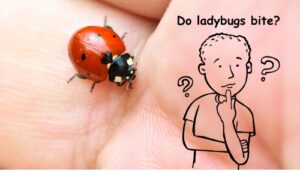
Asian ladybeetles bite the humane and secret a yellow liquid with foul-smelling on the skin. You can find out their difference in the following table. If you buy ladybugs, you are sure about their identity but if you collect them yourself, you must detect them exactly.
| Ladybugs | Asian ladybeetles |
| Their body is rounder and smaller. | Their body is longer and bigger. |
| They have a black head with small white “cheeks.” | They have larger white “cheek” markings on their head that cause you to find their head whiter. |
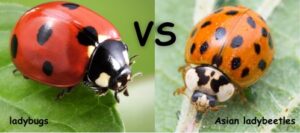
Final Point: Pro Tips About Buying and Releasing Ladybugs to Eat Thrips
Before releasing perchance ladybugs to eat thrips, make sure you prepare all the necessary things to attract them including food, drink and shelter as mentioned above. In the following, you can find pro tips that will raise the efficiency of ladybugs after release.

- Never release ladybugs during the day (especially on warm days). They will fly and leave your house or garden. Release them at night. They never fly in the dark.
- Put their container near your infested houseplant. if you want to release them in the garden, put them near plants that are the house of aphids. So, ladybugs will be attracted to their food after getting up in the morning.
- You can put delicious food such as a card with a few drops of honey near their box to feed on it till find the thrips.
- Spray the nearby plants with water to prepare their drink.
Conclusion
Now, you found out that both larvae and adults of ladybugs eat the thrips and their eggs. We showed you how to attract ladybugs to your garden. You found out where they live and how to collect them to release on your houseplant to eat thrips. We told you pro tips about buying and releasing them on your houseplant or in your garden.
Do you want to buy ladybugs or attract them to your garden? Have you ever collected them and released them on your houseplant? Have you any experience controlling thrips or other pests with ladybugs? Do you know a good brand to buy them? can you explain here? Please share your experience or idea with our reader below this page.

Elahe Rabiei
Hi, I’m Elaheh. My Academic major is plant protection, and houseplants are my expertise. As a houseplant lover, my house is full of indoor plants and it is my passion to take care of them. Hence, I’m here to share my knowledge and experience about growing healthy houseplants. I am also a plant protection advisor, so feel free to ask me any questions you may have.


